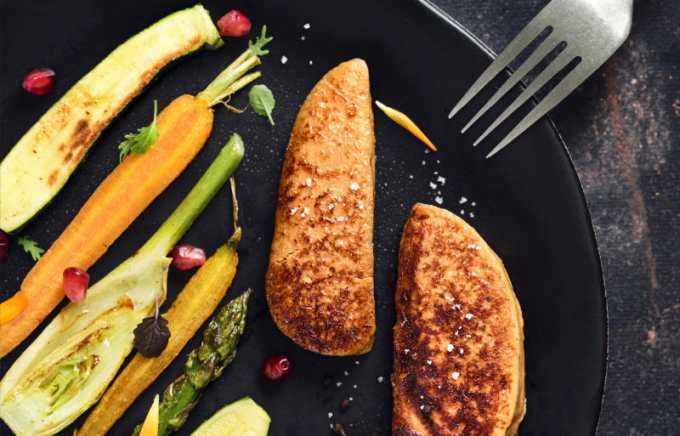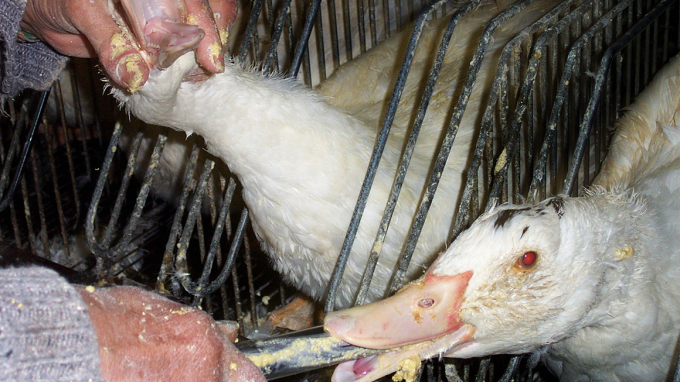November 28, 2025 | 03:46 GMT +7
November 28, 2025 | 03:46 GMT +7
Hotline: 0913.378.918
November 28, 2025 | 03:46 GMT +7
Hotline: 0913.378.918

In an undated photo from Romain Buisson, via Gourmey, foie gras produced from cultivated cells, rather than the fattened livers of ducks or geese. Gourmey, a start-up based in Paris, received an additional $10 million in seed funding this month. The company hopes to find a market in the United States amid growing concerns about animal cruelty. Photo: The New York Times
Last week, Gourmey, a startup company based in Paris, raised an additional $10 million in funding from investors who are betting that it might.
The push to make foie gras, the fattened liver of a duck or goose, in a lab comes amid a push to find a sustainable, ethical alternative to meat raised for slaughter. Most foie gras is made by force-feeding ducks and geese through a tube to engorge their livers up to 10 times their normal sizes. The process can leave ducks too big to walk or breathe, according to animal activists.
In 2019, the New York City Council passed legislation that would ban, starting next year, the sale of foie gras in the city, one of the nation's largest markets, joining California.
Countries including Britain, Finland, Israel and Norway have also banned the production of foie gras, and Britain’s food and safety department said in March that it was exploring further restrictions it could introduce to address welfare concerns surrounding the production of foie gras.
The European Parliament last month called for a ban on force-feeding ducks and geese for foie gras.
With growing opposition to foie gras because of animal-cruelty concerns, Nicolas Morin-Forest, Gourmey’s co-founder and CEO, said producing the delicacy from cultivated cells was a way to preserve a centuries-old French culinary tradition.
“There is a clear and huge market use for an alternative, essentially, that goes way beyond the vegans and the vegetarians,” said Morin-Forest, who grew up eating foie gras each year at Christmas dinner and on New Year’s Eve, as is tradition in France. “Plenty of people are not vegan or vegetarian, but are still not comfortable eating foie gras because of the way it’s produced.”
Unlike plant-based meat substitutes, such as burgers from Impossible Foods and Beyond Meat, cell-cultivated meat is grown from animal cells in a lab. Gourmey engineers faux meat by taking cells out of a freshly laid duck egg and placing them into a cultivator. The cells are then fed with proteins, amino acids and sugar, similar to the nutrients a duck would get from a diet of oats, corn and grass. The cells are then harvested and transformed into foie gras in a process that uses significantly less land and water than traditional methods.
A big obstacle for cellular agriculture is the texture of the resulting food, particularly when making substantial cuts of meat such as steaks. But Morin-Forest said that, on a technical level, foie gras was well suited to be grown in a lab precisely because of its delicate texture compared with other types of meat.

Today, in factory bird farms designed to produce foie gras, geese and ducks are force-fed daily in a cruel way. Photo: SPA
Others had doubts. Marco Moreira, chef and owner of 15 East at Tocqueville in New York City, said he was sceptical.
“I wouldn’t oppose it, but again, I’m a little bit of a traditionalist,” said Moreira, who has several dishes containing foie gras on his menu. “Why mess with something that’s perfect as it is?” Still, he said he was open to trying it.
Investors have poured money into food technology start-ups in recent years amid concerns about food shortages in the coming decades as the global population grows. Cell-cultivated meat does not yet have regulatory approval in most countries, but last year, in a first for the laboratory meat industry, a San Francisco company, Eat Just, won government approval by the city-state of Singapore to sell cultured chicken as an ingredient in chicken nuggets.
One of the biggest obstacles for cell-cultured meat has been its cost. Morin-Forest says Gourmey’s lab-grown foie gras costs less than $1,180 (1,000 euros, or 38,750 baht) per kilogramme. Made in the traditional way, foie gras costs about 100 to 200 euros per kilogramme.
The European Commission and France’s public bank, Bpifrance, have also provided subsidies to support Gourmey, which was started in 2019 and has about 20 employees.
Morin-Forest said Gourmey was seeking regulatory approval from food-safety agencies and hoped to enter the market by late next year or early 2023. Its focus will be on markets such as Singapore and the United States, where there is increasing acceptance of lab-grown meat, he said.
Stéphane Chambon, chef of Le Pont de l’Ouysse, a Michelin-starred restaurant in southwest France known for its foie gras, said that the movement against foie gras on animal-rights grounds was misguided and that the process of raising ducks or geese for foie gras by overfeeding them mimicked a natural one: Centuries ago, when geese and duck crossed the Mediterranean from Egypt, they would eat a lot for energy, causing their livers to engorge, he said.
He questioned how foie gras, grown in a lab, could have the same quality and taste as foie gras grown from ducks or geese raised in a farm. “It’s difficult to imagine this kind of product,” he said.
But he said he was open to trying it: “Why not? Maybe it will be good.”
(The New York Times)

(VAN) A new study reveals how the simultaneous effects of ocean acidification, salinity and loss of oxygen are making the world more fragile.

(VAN) Hopes are growing that the creation of the first 3D turkey gut model could be a turning point in the battle against the virulent blackhead disease.

(VAN) Tyson, America’s biggest meat supplier, plans to shutter one of its largest beef processing plants as the industry continues to struggle with low cattle supplies and political pressure from Washington.

(VAN) New FAO study shows how digital solutions are empowering farmers and fishers to prevent losses and build resilient agrifood systems.

(VAN) Brazil's COP30 presidency pushed through a compromise climate deal on Saturday that would boost finance for poor nations coping with global warming but that omitted any mention of the fossil fuels driving it.

(VAN) Poultry farmers in the UK have been warned that they could face one of the worst winters yet for bird flu.

(VAN) Prices of main-crop paddy have risen sharply, with jasmine rice hitting 16,100 baht per tonne — the highest level in years.